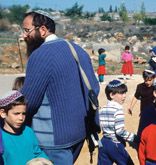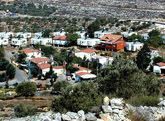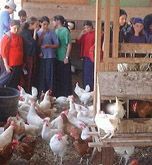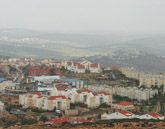
But the residents of Itamar and the other Israeli towns that have taken root in the area since 1967 are just as much associated in the minds of many Israelis and much of the world as extremists dead set against peace between Israel and the Palestinians and determined to expand their presence by violence, if necessary.
 Playground at a settlement in the West Bank
Playground at a settlement in the West Bank
www.israelimages.com Yuli Edelstein, the Israeli minister for Public Diplomacy and Diaspora Affairs, is out to change that as much as he can. Acting as private tour guide to a busload of foreign journalists, his message on a tour of the communities is that life here is very different—indeed very ordinary—in contrast to the images of violence often seen in the media.
“I think it is part of our job to show the real Israel to the journalists,” Edelstein tells The Media Line. “It’s not about telling them how to think or what to think. It’s about learning things, seeing things, talking without interpreters to the residents of this area. We’re not pretending the conflict is not here, but you can probably talk about certain solutions if they are based on facts and knowledge.”
 The town of Itamar
The town of Itamar
www.israelimages.com Itamar sits on a ridge southeast of the city of Nablus. Its 250 families are spread out in compounds up and down the hillside. At the top is Givot Olam, which translates as “hilltops of the world,” and on this clear day, there is some truth to that. The view encompasses the Dead Sea to the east, the Sea of Galilee to the north. and the Mediterranean Sea miles away to the west.
Itamar’s chicken farm produces about 80% of all the organic eggs sold in Israel, residents boast. “People in Tel Aviv who don’t agree with our politics are certainly happy to eat our products,” says Leah Goldsmith, one of the original founders of the settlement in 1985.
Differing Views
The conflict over this region, a semicircle stretching from the Jordan River, is a perpetual battle for the narrative as well as for political control. For its residents and their supporters, Itamar represents the return of the Jews to their ancient homeland, the setting for much of biblical history and the heart of their ancient heritage.
For Palestinians, they are settlers—interlopers, ejecting them from their lands and treating them as second-class citizens in their own country. The two sides can’t even agree on what to call the place. For the Palestinians and the international media, it is the West Bank. For most Israelis, it is Judea and Samaria, the ancient names for the northern and southern halves of the area. For them, Nablus is Shechem, the city’s biblical name. The land is Eretz Yisrael; “Palestine” is a name bestowed on the region by the Romans when they expelled the Jews.
Painful Memories
Itamar has been repeatedly attacked by Palestinians and at least 22 residents have been killed since it was founded in 1984. Last March, two Palestinians from the neighboring village of Awarta sneaked into the home of the Fogel family here and massacred five of them, including an infant. [In January], a military court sentenced one of the killers to five consecutive life terms. The murderers killed Ehud and Ruth Fogel, along with three of their young children, Yoav, 11, Elad, 4, and Hadas, 3 months old, before fleeing the scene.
David Ha’ivri, an unofficial spokesman for the Jewish communities in the area, carefully recounts the murders to the foreign media, who listen spellbound. Some cover their mouths in horror. “They left and heard the baby crying and climbed back into the window and killed her too,” Ha’ivri says. Today, the house is boarded up, but the attack has not discouraged others from joining the community. Since the Fogel family killing, 12 families have moved into Itamar.
“Not Going Anywhere”
 Goldsmith totally rejects the idea of relocating for peace with the Palestinians. “Why is it always that Jewish people have to get up and leave for peace? No, we are not going to go anywhere. This is our land,” she says to The Media Line. “We don’t plan to leave. We don’t plan to make Israel Judenrein.”
Goldsmith totally rejects the idea of relocating for peace with the Palestinians. “Why is it always that Jewish people have to get up and leave for peace? No, we are not going to go anywhere. This is our land,” she says to The Media Line. “We don’t plan to leave. We don’t plan to make Israel Judenrein.”
Ha’ivri says the 30 towns and communities that make up the Samaria regional council are the home to some 28,000 people. Contrary to popular belief, he says, 60% are secular. Ha’ivri himself, a native of New York, is devout and wears long side curls in keeping with ultra-Orthodox religious practice. His great effort to show the “other side” of the settlers is often filled with irony.
“It’s a pleasure to live here. Ten years ago, it wasn’t. It was a sort of war zone, but today it’s pleasant. By the way, we are riding in a bullet protected bus,” he says, referring to the so-called Second Intifada between about 2000 and 2005, when hundreds of Israelis and thousands of Palestinians were killed.
Peaceful Coexistence
 The town of Ariel, another Jewish “settlement” in the West Bank It was important for the government-sponsored trip to show the media that Palestinians and Jews coexist. At Barkan Industrial Zone near Ariel, the biggest Jewish town in the northern West Bank, Palestinian workers at a plastics factory say they prefer to work with the Israelis because they get paid double than what they would make working for a Palestinian employer.
The town of Ariel, another Jewish “settlement” in the West Bank It was important for the government-sponsored trip to show the media that Palestinians and Jews coexist. At Barkan Industrial Zone near Ariel, the biggest Jewish town in the northern West Bank, Palestinian workers at a plastics factory say they prefer to work with the Israelis because they get paid double than what they would make working for a Palestinian employer.
“We don’t talk politics. I come here to work,” machinist Ramadan Islim from nearby Salfit tells The Media Line. “We work together, and for the five years I’ve been here, there haven’t been any problems. What happens outside of the factory is the business of the politicians. We are here to work. We have a home and family to support.”
Yehuda Cohen, the plant’s manager, says he moved his factory here from near Tel Aviv because he needed the space. He adds that the government did not offer him any incentives despite promises. “After I came here, I can say that the Palestinian workers are the best workers that I can find in Israel,” Cohen tells The Media Line.
 It’s a complicated reality but minister Edelstein beseeched the journalists to let the pictures speak for themselves. “I’m not in the business of changing their opinion. I’m in the business of showing them what life is like, showing the facts,” Edelstein says. “I’m sure that none of them heard that there are Palestinian and Israeli workers in the same factory, getting the same salary, and in many cases, the Palestinians being the bosses of the Jewish Israelis. All these things are new. Probably they are not the solution for the conflict, but they are definitely part of the picture.”
It’s a complicated reality but minister Edelstein beseeched the journalists to let the pictures speak for themselves. “I’m not in the business of changing their opinion. I’m in the business of showing them what life is like, showing the facts,” Edelstein says. “I’m sure that none of them heard that there are Palestinian and Israeli workers in the same factory, getting the same salary, and in many cases, the Palestinians being the bosses of the Jewish Israelis. All these things are new. Probably they are not the solution for the conflict, but they are definitely part of the picture.”
For some journalists, it appears to work. Lars Larsen, a conservative U.S. talk show host, says he is delighted to see an alternative view. “The United States is very sympathetic to the Palestinians and, in my point of view, very antagonistic towards Israel,” Larsen tells The Media Line. “This works. We saw people working side by side. That’s a story I’ve never actually read before. You see plenty of stories about who blew up what and who got shot, who retaliated, etc., but you don’t hear stories like this.”
Parting from the journalists, Edelstein has some advice: Try broadcasting their footage without a voiceover and show the beauty of the place and that life is going on. “We want you to see life in Judea and Samaria for whatever it is. Then people can draw their own conclusions, based on facts, based on pictures, based on conversations, and without interpreters,” Edelstein says.
This article was originally titled “The Other Side of Itamar.”
Source: By Arieh O’Sullivan, The Media Line
All logos and trademarks in this site are property of their respective owner. All other materials are property of Bridges for Peace. Copyright © 2025.
Website Site Design by J-Town Internet Services Ltd. - Based in Jerusalem and Serving the World.